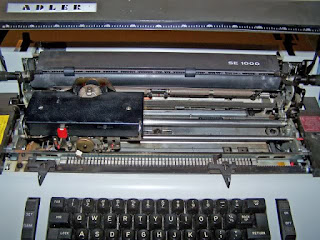Tracker action
Tracker action is also referred to as mechanical action on pipe organs, as opposed to electrical. It's a similar comparison to a manual typewriter and electric typewriter. In one, the keys are connected to each individual letter:

In the other, electric components tell the typewriter which letter to type:

This video demonstrates the tracker mechanism and action (from 3:18 to 3:56):
powered by Splicd.com
As you can see, comparing this action to the manual typewriter's action helps visually explain this action (to those of us familiar with these typewriters).
When couplers are used on an organ which utilizes tracker action, the coupled manuals' keys are also depressed.
Here the Great and Swell are coupled to the lower keyboard (from 5:14 to 5:27):
powered by Splicd.com
Finger Strength
As you can imagine, the more stops and/or couplers used, the more manual strength is needed to overcome wind pressure in order to to play the keys. On larger organs a Barker lever/machine or other pneumatic action is often employed to ease the pressure needed.
Tracker and the Allen AP-22a
While the new Allen organ being installed in LDS buildings is not a pipe organ, the touch of the keys mimics the feel of a tracker. Many pianists have remarked that the touch feels more like that of a piano. as there is now a slight resistance to the manuals. The couplers, however, use electronic action.
In Conclusion
Many of my readers don't have the opportunity to play on a pipe organ with tracker action. However, if you ever get that opportunity, I recommend taking it, or searching it out. I think it's a lot of fun to play these manual pipe organs.
There's a great view of the keys on coupled manuals in the first minute of this video:




It is a little late to comment, but I just discovered this blog and I love it!
ReplyDeleteI am quite the lucky LDS organist. Our stake has an electro-pneumatic 16-rank pipe organ installed in our building. I'm currently trying to convince the stake to purchase another pipe organ from another church that is selling off their small 4 rank organ for $5,000. I doubt it will go over well, the stake that purchased the pipe organ in the 1960s has a far diffierent attitude towards music than the current stake.
Anyway, I play on that for LDS services, but I also play professionally at a local congregation. They have a small 12-rank self contained tracker organ. I must admit it was unusual getting used to it, but now I love the feel so much more than the electro-pneumatic action of our Casavant at the LDS chapel.
The hardest thing to get used to was the pressure when using the couplers. The congregation is small (120 members usually show for Sunday services) but they are incredibly enthusiastic in their singing. This requires me to pull out all the stops (minus celestes) and the pressure becomes quite intense on the great manual.
Our local AGO chapter hosted our local Pedals, Pipes, and Pizza there this year and the kids went wild. The organ is self contained and can be wheeled around the room, so the tracker action was at eye level with the children and they were able to observe it quite intimately. It was also at that time we found a couple of mice living directly under the bellows. :)
On this particular organ the reversibles prove to be difficult as sometimes the piston doesn't quite have the "strength" the pull out the combinations. Nonetheless, I love playing on it. I believe that it was built better than our Casavant at the LDS church and has a far better selection of stops (it uses quite a few rank extensions).
I would avoid Allen’s “tracker touch” like the plague. I have a 3-manual French custom Allen with tracker touch and it is so noisy that it sounds like hitting two sticks together on each note. BEWARE: it’s a horrible situation. I innocently specified it when I bought my instrument because I’ve played tracker pipe organs my whole career and love them. None ever sounded like this catastrophe. And don’t expect Allen to fix it. They disappear like magic once they sell the instrument. You will be at the mercy of your local sales agent.
ReplyDelete